The Story Behind Robin Hood
The genesis of Ridley Scott's latest historical epic...
For certain children of the ’ 90s (and no doubt a few begrudging adults), the name Robin Hood is forever synopsis with mullet haircuts, bad accents, and Bryan Adams’ rock balladry.
Like Bond, every generation has their Hood. In the early 1990s, director and star Kevins Reynolds and Costner all-but defined that generation’s notion of what and who Robin Hood was with their factually-questionable, heavily romantic Prince Of Thieves .
Before that, the ’20s had Douglas Fairbanks; in the ’30s and ’40s it was Errol Flynn robbing the rich; the ’70s boasted Disney’s fruity, foxy interpretation; and the ’80s earned themselves Michael Praed as their bow-and-arrow saviour.
Now, nigh on 20 years since Costner, Ridley Scott and Russell Crowe are wading in with their interpretation of the enduring myth.
But what began as a project that boasted something of a break in the myth’s seemingly straight-forward binary narrative (which generally reduced the entire legend to Good Hood fights Slimy Sheriff), has turned into a more traditional take on the tale.
Back in July 2007, Sir Scott told us: “The idea is to make the Sheriff of Nottingham a little less of the villain – to clean up the character a bit and make him more interesting.”
Fast forward almost three years, and his vision for the project has dramatically changed. Robin is once again the recognisable hero of yore, and Mark Strong’s Sir Godfrey seems to be the main antagonist instead of Nottingham’s seedy Sheriff.
Sign up to the GamesRadar+ Newsletter
Weekly digests, tales from the communities you love, and more
So how did Scott’s revisionist take evolve into its present form? Let’s take a look...
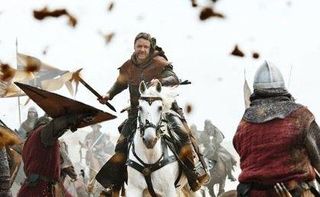
Next: Robyn Hode [page-break]
Robyn Hode

Let’s start at the very beginning. Robin Hood’s roots in myth and legend were established as early as the 1200s, when English judiciary documents listed the names 'Robinhood', 'Robehod' and 'Hobbehod' in their records.
Far from being the alums of specific individuals, it is believed that the moniker was used in reference to anybody considered an outlaw or a fugitive (much like our common use of the name ‘Gary’ for young car-tinkering aficionados).
The term survived to as late as the 16th century, when anti-government plotter Guy Fawkes was condemned as a Robin Hood by the Earl of Salisbury, Robert Cecil.
Conflicting and contradictory reports cause confusion about the various instances in which a Robin Hood hero first appeared.
But it is generally agreed that the first concrete allusion to the character came about in the 15th century, when narrative ballads set in Nottinghamshire rhymed “Robyn hode in scherewode stod”.
Geographic technicalities not-with-standing – various incarnations of the legend have location Mr Hood in South Yorkshire, while positing that he was born in Loxley in Sheffield – it is generally accepted that he was a loveable rogue with good intentions.
Just ask Russell Crowe, who considers himself something of an expert on all matters Hood.
“Having read some 20-30 books on the subject, some of them highly intellectual and some of them purely fantasy and entertainment, there is a period of 300 years in which this legend seems to have been created,” he says.

“Between 868AD - when there is the ballad of Robin the Beheader, which is a man who lives in the forest and robs people and chops off their heads, and sometimes their hands - all the way through to the romanticised version of Robin Hood, it’s a thousand years of storytelling.
“I think it’s the oldest fictional tale in the English language, and on top of that you have another hundred years of cinema history, you know?”
Early accounts of the hero began with Piers Plowman’s 14th century poem, which referenced the narrative ballads.
But it was the 15th century ballads themselves – and notably a manuscript entitled Robin Hood And The Monk , now housed in Cambridge University and dating back to 1450 – that established many of the hallmarks of the legend.
Here, Hood’s expertise as an archer, his Marianism (his study of Jesus’ mother) and his animosity towards the Sheriff of Nottinham were all prevalent.
Says Crowe: “Certain things that we come to think of as being absolute in terms of Robin Hood, certain names like Loxley or whatever, then you find out that only came in recently in 1890 with a book and that was never there before.
“But this thing has been a myth, a legend, a parlour game, a political tool long before it ever became a Kevin Costner movie.”
Next: Nottingham [page-break]
Nottingham

In February 2007, it was announced that a 21st century envisioning of the Hood legend was making its way to the big screen.
Bulletproof Monk scribes Ethan Reiff and Cyrus Voris offered Hollywood execs a peek at a spec script they had put together entitled Nottingham , which put a 180 spin on the original myth.
Repositioning the Sheriff of Nottingham as the misunderstood good guy, and Robin Hood as one of the film’s central villains, it took the characteristics of the 15th century legend and told them from a fresh, perhaps more factually accurate perspective.
The studios loved it, scrapping in a bidding war that saw Universal Pictures emerge victorious over New Line Cinema, Warner Bros and Sony among others, paying the writers seven figures for their spec.
It was something of a record in script selling, The Hollywood Reporter noting that Universal nabbed the rights to the manuscript just 36 hours after it went on sale. “And the writers - whose Sleeper Cell Showtime had cancelled on January 25 - became part of one the biggest deals in some time.”
Eyeing a summer 2008 release, the studio quickly scooped Russell Crowe as the Sheriff of Nottingham, coughing up a reported fee of $20m. Meanwhile, Bryan Singer, Ridley Scott and Sam Raimi were all names dropped into a hat for directing duties.
A month later, Ridley Scott jumped at the chance to re-team with his favourite Australian man-mountain for a fifth time. With Brian Grazer on-board as producer, production on the film looked set to commence in early 2008.
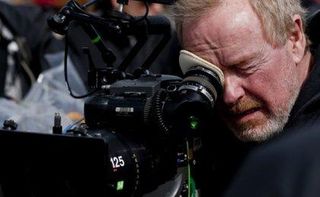
How did Ridley feel about helming his own Hood tale?
“I think there’s been 80 made over the years and it’s the kind of thing I used to enjoy as a kid, but when I revisit them, they’re not very good. I’m trying to think of the last good one. Errol Flynn... God bless him. The one I thought was best, frankly, was Mel Brooks’ Men In Tights !”
Speaking with MTV , Grazer called Nottingham “the Gladiator version of Robin Hood. I think it will have the same propulsion that Gladiator had - the same adrenaline hits.”
Meanwhile, Scott (ever the perfectionist) said he was most excited about attempting a historically accurate portrayal of the circumstances of the time.
“Richard the Lionheart is on his return from the Crusades [ when ] he took an arrow in his neck and died. His brother, John, [ becomes king ],” he explained, before going on to insist that King John “was actually pretty smart, but he got a bad rep because he introduced taxation. So he’s the bad guy in this.”
The director adds that “you've got the returning Nottingham who is the right hand man of Richard and witnesses Richard taking the arrow. And so he comes back to England to carry forward Richard's dream about England.”
Where does the newly sympathetic Sheriff fit into all of this? He’s stuck between a rock and a hard place, caught in the middle of two wrongs as the King orders him to arrest outlaws, while outlaw Hood threatens to lead the public in anarchy.
Says Scott, he’s wedged between “the minority of haves and the majority of have nots”.
Things, however, were about to hit the skids...
Next: Delay [page-break]
Delay
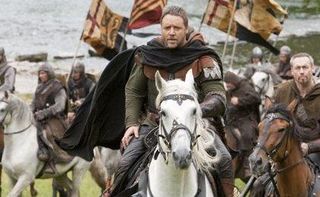
“We're both kind of fairly outspoken,” Scott says of his working relationship with Russell Crowe.
“I think we tell the truth. We communicate with each other that way. And he's probably one of the best two or three actors out there right now and has been for a while. He's just a very fine, inventive chameleon. He's one of the few actors who can literally change.”
Crowe returns the sentiment, agreeing that he and his director have perfected the “art of the wordless argument”.
“What we learned doing Gladiator is we really enjoy being on a set together. We enjoy the rhythms and the energies we both bring to the job,” says the actor.
“What I like most about Ridley Scott is that he's the guv'nor - he's the boss. He begins at the visual and he sees things before you even shoot them, so he can talk to me right at the beginning of the process in terms of what he needs from me.”
But the pair’s rejuvenation of Robin Hood was about to fall victim to the US writers strike in January 2008. With production on Nottingham set to commence with filming in Northumberland, the shockwaves of the strike in Hollywood rippled out to the British-based production.
Amid concerns over an unfinished script, adverse weather conditions and financing, Universal spokesman James Hail said: “They are looking to reschedule it, but whether that has an impact on this region or not remains to be seen.”
As the movie-making cogs slowed, the production focussed instead on other, more manageable areas: namely casting its remaining characters.
On 18 June 2008, the BBC reported that Sienna Miller had been cast as Maid Marian. “It's ridiculous,” the actress said. “There's this looming actor's strike, so it's not 100% sure that it's going to be made, but it's looking pretty certain.”
The very next day, news that Christian Bale was in line to star as Robin Hood caused confusion. The, ahem, ever-dependable Daily Mail reported that Bale would be “part of a menage a trois between Russell Crowe's Sheriff of Nottingham and Sienna Miller's Maid Marian”, while stating that “costume fittings begin next week, so he'll be either in or out by then”.
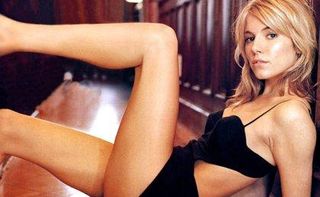
But the Latino Review , far more reliable than the Mail , reported that Russell Crowe was keen to bag Control’s Sam Riley for the role, poo-pooing the Mail ’s report.
The Mail got one thing right, though – Vanessa Redgrave and William Hurt were both in talks to take parts in the flick.
Seizing on the slowed production, Ridley Scott also decided to take the original spec script in a different direction – bringing Robin Hood back into the hero fold, while beefing up the historical context. In August 2008, he brought in Brian Helgelund to give the material a re-jig... but wasn’t happy with the result.
Enter Paul Webb, writer of a script called Lincoln , which Spielberg was eyeing to direct, and Selma , which only now is being made by Precious’ Lee Daniels. As Webb prepared to write a whole new script using Scott’s notes, these new developments shoved the film’s release date back to November 2009, with shooting pegged for early 2009.
Talking of beefing up, Las Vegas trainer Joe Abunassar – renowned for working with many an NBA star – was sent to Australia to get Crowe into shape after he piled on the pounds for Body Of Lies .
Universal chairman Marc Smuger explained why: “Ridley's vision of the movie is very visceral, very physical - you're really in the forest, pulling back a giant bow.
“Those bowmen were extraordinary athletes. I don't know the pressure per square inch, but it surely took a real athlete to handle the kind of bows they used back then. But that's the point - this movie is going to feel real. It makes a legend we all know feel historically relevant.”
Crowe seems dedicated to the cause. “The world doesn't need a mundane version of Robin Hood,” he says. “If we're gonna do it, we've got to kick some serious butt.”
Next: Double Act [page-break]
Double Act
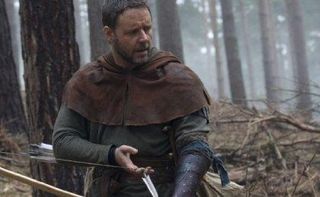
By September 2008, the shifting sands of Ridley Scott’s Nottingham meant that confusion about the project was rife, with rumour and all-out lies plaguing the film’s production.
‘Russell Crowe Will Play Robin Hood AND The Sheriff In Ridley Scott's Nottingham' screeched MTV , before going on to report that Scott had revealed Crowe was “playing both!” parts in the film.
Mischievously, Scott added cryptically that the dual role would include “a good old clever adjustment of characters. One becomes the other. It changes.”
Come November, Scott was evidently regretting his cheeky remarks, which were either being dismissed as red herrings or taken to a rather literal extreme in which Crowe would essentially be fighting against himself. Speaking with MTV again, the director attempted to clear up the confusion.
“In the context of the story, he starts off as one thing, becomes the guise of another and then has to retire to the forest to resume his name Robin. So he was momentarily the Sheriff of Nottingham.” Um, thanks Ridley.
Meanwhile, Mark Strong was drafted in to play Sir Godfrey, replacing the Sheriff as the central villain.
“He's such a good bad guy,” said Scott. “He's going to be horrible, actually, as bad as I can make him. Mark's a very good horseman and swordsman so we'll definitely use that.”
And, just to make sure we really were all on the same page, producer Brian Grazer cleared things up over the dual role thing once and for all.
“The two role confusion is that what Robin Hood does is he sees Nottingham in battle very early in the movie and Nottingham dies,” Grazer says. “And Robin Hood takes over the identity of Nottingham. That’s how it plays out.”
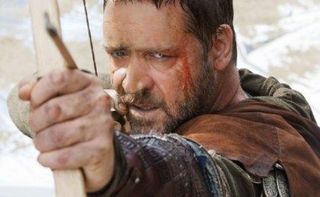
With the dawning of 2009, everything was looking slightly more positive on the Nottingham front. The film’s title had been retooled from Nottingham to the much more straight-forward Robin Hood (perhaps to help geographically-challenged Americans as much as reflecting the film’s change in priorities). Shooting was ready to go in April.
Scott revealed more about the plot and what we should expect from his very specific vision of the Hood lore.
To begin the film, “Robin Hood is in the army of Richard Coeur de Lion. He is a bowman in the army of Richard Coeur de Lion.”
As far as the dual role went, the idea was completely scrapped. “It is better to simply have the evolution of a character called Robin Hood, who will come out of a point in the Crusades which is the end,” explains Scott.
As a consequence, the Sheriff is “less important; the Sheriff of Nottingham is always a kind of an amusing character in most of the movies, who represents the hierarchy in the story at that point.
So who will be the real villain of the piece? Apparently the greatest threat comes “from France. It is the French. The villain is much bigger in that sense; much more important, and much more dangerous.”
And any worries that Crowe wouldn’t be able to slim down after Body Of Lies and fit into Hood’s suit were quickly quelled. “He’s been working on his bow and arrow for about 4 months,” Scott said. “He sends me tapes of him hitting targets at about 45 meters. He’s pretty good!”
Next: A New Queen [page-break]
A New Queen
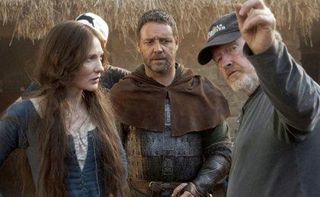
With Sienna Miller deemed too slim and young to play Maid Marian, chatter in February 2009 quickly turned to who would replace her.
The Telegraph got the scoop first, speaking with Mark Strong, who said: “I think Cate Blanchett is set to take the Maid Marian part. She is a wonderful actress and it would make it a much classier film if she was in it.”
Days later it was a done deal. Meanwhile, the film’s budget was revealed to be $130m, while Scott was aiming for a PG-13 rating Stateside (which would probably translate to a 12A over here).
Producer Grazer was overjoyed with Blanchett’s signing, saying that she and Crowe were “both highly accomplished dramatic actors who are taken seriously playing rich characters in period pieces, but each has the ability to show you fun”.
Casting was now in full swing, and production looked positive, having seized on attractive tax breaks by scheduling to shoot in London.
Crowe’s friend and former bandmate and frontman for Great Big Sea Alan Doyle signed on to play Allan A’Dayle, who revealed that the film would involve “a lot of singing”.
“He’s a troubadour,” Doyle said of his character. “He’s an Irish lute playing balladeer. He’s an artist who loves to sing a song. With two or three other guys, Allan A’Dayle is one of the Merry Men who’s followed Robin Hood for a long time and hopes to continue to do so. Yes, I will be playing the lute in the film.”
“A lot of it by different people in different parts of the film. I don’t know quite yet if Russell and I will be singing together. But there will be lots of music in the film.”
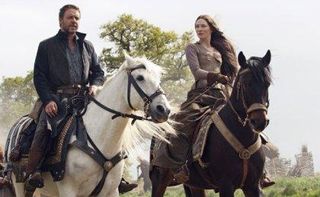
By 24 March 2009, the cast had ballooned its line up, with Vanessa Redgrave playing Queen Eleanor of Aquitaine, Oscar Isaac as King John, Kevin Durand as Little John.
A month later, William Hurt signed up to play William Marshall, a notorious historical figure whom Stephen Langton, Archbishop of Canterbury, called the “greatest knight that ever lived”.
In May, Vanessa Redgrave sadly withdrew from the project in the wake of her daughter Natasha’s tragic death. The role would have been her first after her daughter’s passing. In her place, Dame Eileen Atkins accepted the part of Queen Eleanor.
The actress admitted that she was “terrified” about the project. “They keep rewriting the script and changing my lines quite dramatically,” she said. “So I'm terrified of forgetting them.”
Next: Tightening The Bow [page-break]
Tightening The Bow
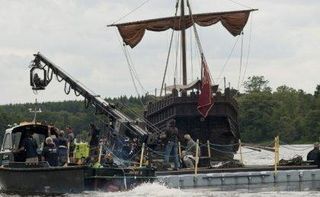
“He doesn’t have the old Robin Hood tights. He’s got armour,” revealed producer Grazer of Crowe’s look, as shooting commenced in April 2009. “He’s very medieval. He looks, if anything, more like he did in Gladiator than anything we’re used to seeing with Robin Hood.”
The first image of Russell Crowe as Robin Hood was released. The actor was relieved to not be in tights: “I will not wear tights because according to our research they weren't invented for another 300 years. I apologise to you all.”
Meanwhile, the paparazzi managed to get on-set, leaking snaps of shooting taking place in the English countryside. The images revealed some epic battle scenes that took place in Bourne Wood, Surrey.
Dame Atkins revealed she would be working with an owl – and she was still terrified.
“I am completely bird phobic - it’s the same owl that appeared in Harry Potter and apparently it weighs as much as a dog. I have to feed it - probably dead mice - and I’m going to go to an animal sanctuary to help me get over my phobia.”
As shooting continued, it was revealed in August that Warner Bros were planning their own Hood film – but theirs would feature an out-there sci-fi twist. Danish director Nicolai Fugslig signed on, while producers revealed that it would be “a futuristic action adventure” both “inspired by and pay homage to the legend of Robin Hood.
On 14 December, with the film in the can, Universal released their first trailer for the film...
It fostered a mixed reaction, with many viewers calling it ‘ Gladiator In Tights ’, recognising in the footage a similar look and tone to the other historical Ridley-Russell team-up.
Just a week later, Universal released Robin Hood ’s first international trailer, which turfed out the original teaser’s rock soundtrack in favour of a more traditional approach...
Meanwhile, Robin Hood became the first post- Avatar film to get caught up in the 3D race, with rumours circulating that the film might be converted into 3D for its release.
It was claimed that Ridley Scott was “breathing down the neck of executives at Universal to get them to approve making a 3D version of his new $200 million epic, Robin Hood ”.
The Wrap magazine reported: “One knowledgeable executive told me that it would cost only an additional $7 to $8 million to create a 3D version of Robin Hood. The question is - what will that add to the box-office total?”
Scott confirmed that he was keen for the flick to go the multi-dimensional route. “I’ve seen some of James Cameron’s work, and I’ve got to go 3D. It’s going to be phenomenal,” he enthused.
In the end, though, nothing came of it. Robin Hood will be released ‘traditionally’, without any 3D tampering.
Next: Robin Hood [page-break]
Robin Hood
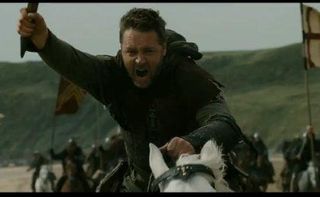
“I think that there’s something wonderful in a story that’s latest for so long,” says Russell Crowe.
“The core thing that has attracted me since I was a five-year-old kid is that there’s some guy out there who will go and work on behalf of the people who can’t do something for themselves. There’s a guy there who’ll rob from the rich and give to the poor.”
As Hood nears its final release date of 14 May, a whisker shy of two years after its initial proposed release, news has broken that the film will open the Cannes Film Festival on 12 May.
Which could either sound Hood ’s final death knell - if Cannes reports are negative - or foster the hype into a frenzy just in time for its worldwide bow two days later.
Russell Crowe remains positive.
“I've loved Robin Hood since I was a kid,” he says. “I spent 10 months just reading Robin Hood books – the history, the mythology, the original ballads, the legend – and then you've got 100 years of cinematic history as well. So this has got to be the best one ever done, otherwise I should be doing something else.”
Despite reports of his on-set huffs with Ridley, the Australian actor remains nothing but in awe of the 73-year-old director.
"The thing I love about working with Ridley is that you always finish the day feeling like you've done a day's work. That doesn't always happen on a film. Sometimes you knock around for days, thinking, 'This is getting nowhere.'
“It's a working man's dream. The way to make films is the way Ridley makes films: no mucking around; we're all gonna work really hard and if you can't stand the heat – whoosh! – get outta the kitchen.”
Meanwhile, Ridley can’t wait to show the doubters that he’s been right all along...
“Well, think of Gladiator . Everyone sniggered because I was going to do a sandal and toga movie. But I knew exactly how to do it and I know how to make Robin Hood . You step forward and make it real for a start. You choose a sensible moment in history.”
Ridley, we’re there. It’s been a long, torturous journey, taking twice as long as anybody ever expected it to, but the director’s take on the tale looks to be its most definitive. Bring on May.
Like This? Then try...
Sign up for our free weekly newsletter here .
Follow us on Twitter here .
Josh Winning has worn a lot of hats over the years. Contributing Editor at Total Film, writer for SFX, and senior film writer at the Radio Times. Josh has also penned a novel about mysteries and monsters, is the co-host of a movie podcast, and has a library of pretty phenomenal stories from visiting some of the biggest TV and film sets in the world. He would also like you to know that he "lives for cat videos..." Don't we all, Josh. Don't we all.
Most Popular


